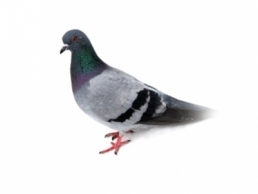
How to Identify a Pigeon
Pigeons can be raised for food, racing, and the delivery of messages. Other than those reasons, pigeons are mostly known as great wildlife pests.
Pigeon Appearance
Pigeon bodies are traditionally gray with a whitish rump, but the birds may also appear in shades of white, tan, and black. They have characteristic double black stripes on their wing feathers, a single black band on their tail feathers, and bright red feet. The average pigeon weighs 13 ounces and measures 11 inches in length.
Pigeon Habitat
Pigeons are dependent on human activity for sustenance, pigeons are cosmopolitan in distribution and build nests of sticks, twigs, and grasses in lofts, steeples, attics, caves, parks, warehouses, on bridges, and anywhere architectural features allow for roosting.
Pigeon Problems
How Pigeons Make Entry
Pigeons are dependent on humans and orient themselves near areas of consistent activity. They commonly nest in ornamental lawn trees, barns, attics, and on roofs of homes and businesses. Since their preferred food sources include grains and seeds, garbage, the manure of livestock, insects, and nearly anything people will feed them, pigeons are also commonly found on farms, in places of business, and storage facilities like feed mills and grain elevators.
The Damage Pigeons Cause
Pigeons are actually quite filthy animals that tend to create terrible messes. Their droppings are abundant wherever infestations are present and stain building facades, park benches, statues, and cars. In addition to being displeasing to observe and smell, pigeon droppings also accelerate the deterioration of building materials. Furthermore, their excrement contains pathogens of numerous diseases and can also harbor fleas, lice, mites, and ticks in their feathers. Their roosting habits have also contaminated stores of food meant for human and livestock consumption.
Pigeon Control and Safety
Since they are drawn to nesting sites where food is abundant, pigeon control must center on the elimination of food sources. To keep pigeons out of parks, feeding should be strictly regulated. To keep the pests out of residential yards, property owners should seal trash bins, remove collections of debris, and trim trees and shrubs. Additionally, a number of products exist to keep pigeons from nesting on structures. Mesh netting and bird spikes, for example, can both be utilized successfully to stop the birds from nesting on roofs, in barns, steeples, and on building ledges.
Pigeon Trapping and Removal
As pigeons spread a number of diseases, individuals are safer not approaching them. In areas where pigeon infestations threaten the general public’s health and well-being, pest control professionals should be called in to handle the problem. The trained technicians at Critter Control have the tools and knowledge of pigeon behavior to effectively and safely remove the birds.
We can help you get rid of pigeon problems.



